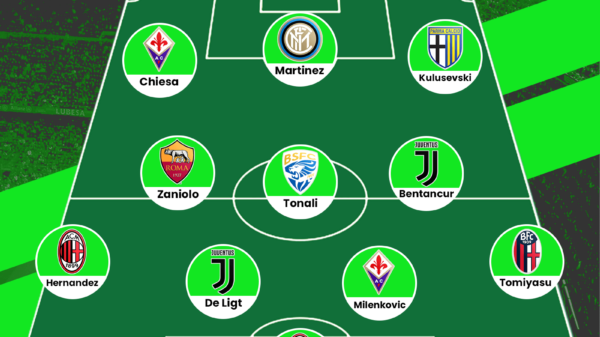The Catenaccio was one of the most infamous yet effective football formations, one that particularly brought Italian sides years of success. Joseph Solomon documents the origins of this tactical approach, and it’s development.

“John, you’re immortal now” – Liverpool’s legendary manager Bill Shankly praised Celtic’s manager Jock Stein, after his side edged Inter Milan 2-1, in the 1967 European Cup Final.
“It was inevitable. Sooner or later the Inter of Herrera, the Inter of catenaccio, of negative football, of marginal victories, had to pay for their refusal to play entertaining football” said Portuguese newspaper, Mundo Desportivo
Catenaccio! A word which even today strikes fear into the hearts of footballing fans, players and managers alike, is often lamented as a parasite to the word, ‘football’. Symbolizing all that is bad in football, Catenaccio accommodates defensive play, aggressive fouling, cynicism, intimidating opponents, alongwith a penchant for what is called nowadays- boring football.
Football is a beautiful game and teams which kill this scenarios, are often crucified. From Jose Mourinho’s approach with Chelsea in 2005, which ultimately led them to conquer the Premier League after 50 years of wait, while dubbing them as ‘Chelsea 1-0’ to Greece’s approach which led to them winning the 2004 European Championship, teams are often battered and bruised for having a defensive approach to the beautiful game.
But, where did this defensive approach initiate from? Where did the thinking of playing with men behind the ball or sitting deep into one’s half, while attacking from counters, originate from? We all know, the W-M of Herbert Chapman or Rinus Michel’s Total Football, were not the conspirators, so then who was it? Who masterminded this defensive approach, which would later be a boon for Lower Division Teams?
“Football is simple, but the Italians ruined it” said one of my friends, when talking about tactics and tactical evolutions. Did the Italians really ruin it, or did they adopt a plan which would guarantee success?
Italian Football, has often been lamented for being defensive, but as John Foot puts it in his book Calcio: A History of Italian Football, Italians are not defensive, they are simply better in defending, a statement which relies on the Italian crop of Paolo Maldini, Fabio Cannavaro and Alessandro Nesta, all of which were better at passing and could manipulate the ball to their advantage, whilst being tactically perfect.
The term ‘defensive’ has been stuck to ‘calcio’ ever since Gipo Viani and his primitive Catenaccio. Yes, Karl Rappan was the inventor of perhaps the most sinister formation ever, the Catenaccio or as they say in Swiss ‘The Verrou’, but Catenaccio (an Italian term), was generated by Gipo Viani, which was totally exclusive of the evolution in Rappan’s Switzerland. Nonetheless, among the many theories of how Catenaccio developed in Italy, Gipo Vianni’s claim to be the originator seems the best, as his Salernitana were the first to deploy a player behind the defensive line.
The ‘Vianema’
Gipo Viani, realizing the limited amount of resources at his disposal, decided to innovate his side tactically and tried to bound them as a single cohesive unit, while avoiding single one on one battles on the pitch. Allegedly inspired by a real life situation, of a reserve net behind the main net to catch fishes, Gipo started to line his team in the same scenario, a defensive player behind the main line of defence.
One of the notional halfbacks, Alberto Piccinini, dropped in deep to mark the opposing center-forward, with one of the three central defenders operating in a W-M falling back as a sweeper. Viani, then had his team sit deep, drawing out opposition, leading them to commit extra men leaving them vulnerable to counters, which Viani heavily relied on.
A small side struggling in the gallows of Italian Football, gained promotion in 1947 and boasted the best defensive record of any team in the three adjacent second divisions. Although their romantic debut in the Serie A was cut short as the side was subsequently relegated, failing to win even a single away match.
Though Gipo’s Salernitana might be successful in its endeavours, this approach instigated other ‘small’ teams to adopt and exercise as Jonathan Wilson puts it, ‘the right of the weak’. Smaller teams soon began realising that they stood no chance if they turned the game into a series of individual battles, hence reverted to commit men behind the ball.
While Nerro Rocco joined this party with Trisestina, a side which was crumbling in the Serie A. Rocco was appointed in 1947 when Triestina were in a mess, finishing bottom of Serie A in the season before, only to be granted exemption due to the side’s inability to play away matches as British and American troops still occupied the city. In Rocco’s first season the team flaunted its unbeaten record at home and finished a joint second. Two successive eighth placed finishes followed Rocco, in the seasons next, as this tactical evolution was seen as a perfect set by smaller teams to rue the ‘Giants’ of Serie A’s chances.
Along comes Inter
Internazionale Milan under Alfredo Foni was the first major Serie A giant to identify this system, as an outlet to win trophies. Although, big clubs in Italy were supposed to be free scoring and hammering teams with vast differences, only Foni was the first to initiate a ‘defensive’ approach during the 1950s with Inter. Foni, chose Ivano Blason as the club’s sweeper (or libero). When Blason joined from Trisestina, he had been a clumsy full back, while proving to be a defensive liability; in his new found role Blason developed as the first great libero, highly acclaimed for his long clearances and uncompromising nature.
Legend has it that Blason before kick off would draw a line on the pitch and tell the opposing forwards, that under any circumstance they were not allowed to cross it and if they did, they would face the wrath of the imposing Italian. Blason was not an elegant libero, unlike Gaetano Scirea who came years later and contributed to the growth of the libero position; Blason was literally a hacker – who just cleared balls thrown into his domain. Hence libero was originally called as battitore libero or ‘free hitter’ as the man playing the role would hit the ball long with his first touch.
With Gino Armano, the right winger, dropping back to mark the opposition’s left winger, Ivano Blason who usually played as a right back was transited into the sweeper role. Upfront, Inter had speedy and skilful forwards with the ability to break defences and thus the perfect recipe for a successful catenaccio started to bud. Simple is as simple does, a long ball which was often launched by Ivano Blason often found pacey Inter forwards, Gianni Brera.
Riding on the back of a defensive padlock, Inter Milan won the 1952-53 season scoring 30 goals fewer than second place Juventus, whilst conceding less than one goal a game. Despite their scudetto triumph, Foni’s tactics caused something of a scandal. Inter Milan were largely critisized by the media because of their defensive approach to the game despite boasting a frontline which consisted stars such as Benito Lorenzo.
Roots of Catenaccio were already initiated in the Milan soil, and later in the early sixties this trend of defensive football would go on to become one of the most hated formations with Helenio Herrera’s Ill Grande Inter.
Default Template
With Inter Milan enjoying success in the early 1950s, other Italian clubs who had no problems with this defensive approach adopted a ,as they claimed, ‘safe style of football’. Though, many clubs succumbed to the perils of this catenaccio, largely due to the lack of suitable men in suitable positions, others benefited from this tactical reform.
Maradei concluded, ‘It was quite revolutionary, you have to remember that at that time, the scudetto winners regularly scored around a hundred goals’. Perhaps, the Italian was looking flabbergasted at the bigger picture of guaranteed success, whilst compromising on the number of goals scored. Beautiful indeed?
Variations on the default template laid by Gipo and Foni came up. Fiorentina, for instance, won the scudetto under Fulvio Bernardini in 1956. Their tactical reform was quite simple, the left half Armando Segato played as a libero and Maurilli Prini, the left winger retreated as a ‘torante’ – returning wingers. Although this same approach was initiated by the title winning side of Inter Milan in the early 50s, Fulvio added an extra dimension to his formation. The inside left, Miguel Angel Montuoro, would adjust into the space vacated by Maurilio Prini- the returning winger, and provided Fiorentina with a spare center forward.
With this slightest of tactical reforms, Fiorentina won their first ever Scudetto, whilst going 33 games unbeaten and hammering Juventus 4-0. Perhaps, Catenaccio became the default template of every team at that point gunning for success and these slight alterations proved to be the difference between trophies.
From Fulvio to Herrera
Seen as a default template, the catenaccio approach was there in almost all Italian teams. Lamented for being defensive, the league turned out to be disappointing due to the lack of goals for many fans and critics, alike. The initial W-M was finally transformed and converted into a much more sinister looking formation, playing with a libero. Nero Rocco at AC Milan, first displayed the true potential of catenaccio in Europe, while even Bela Guttmann’s Benfica showcased signs of the tactical evolutions going around in Italy.
It was finally Herrera at Inter Milan that took charge of something ‘special’ be it negatively. Herrera converted Inter Milan, into one of the top dogs in Europe as well as Italy. But, ironically history remembers Il Mago’s Inter for all the wrong reasons.
Catenaccio was something that was lying buried in Italian hearts, regressing slowly and gradually. As Pier Paolo Pasolini points out “Catenaccio was as if it was a part of the Italian character, as is probable, it could not be invented. They were already there.”
Special mention to Jonathan Wilson for his little inputs.
Written by Joseph Solomon
- Hellas Verona: The Brigate Gialloblu - February 3, 2015
- Watercarrier: An Evolved Position - January 28, 2015
- Can a three man defence work in the Premier League? - January 27, 2015
























































